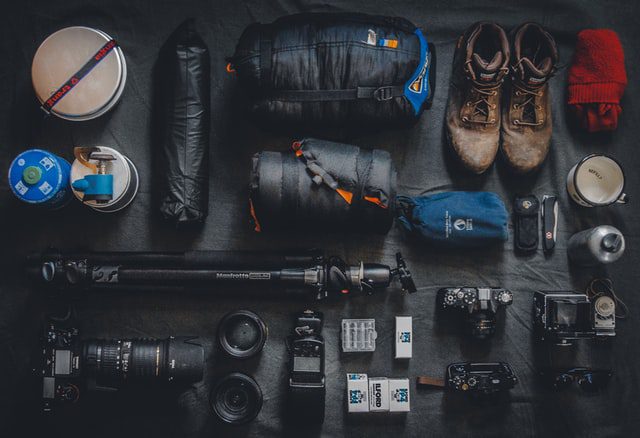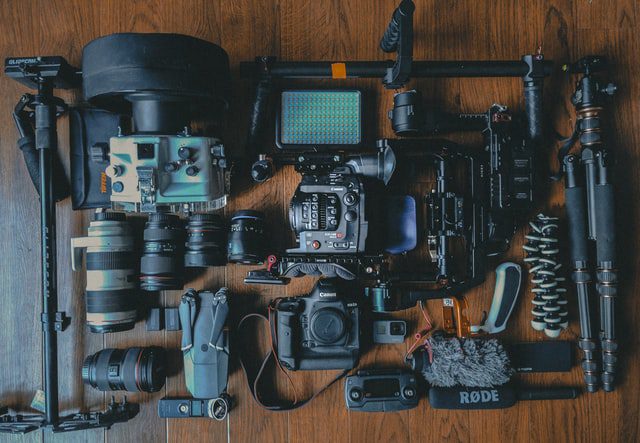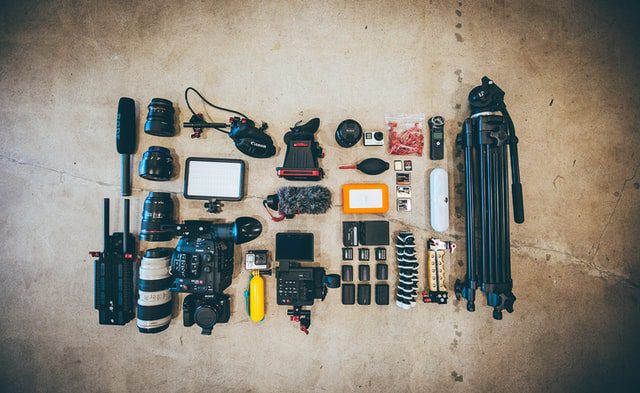Embarking on a visual storytelling journey means we’re diving into a world where the right camera gear can turn a good shot into a masterpiece.
We’ll explore the essentials, from the body to the lens, and why each piece is crucial for capturing those breathtaking moments.
Understanding camera gear is like learning a new language; it’s the key to expressing our vision with clarity and impact.
We’re here to guide you through the choices, whether you’re a seasoned pro or just starting out, ensuring you’re equipped for any shot that comes your way.
CAMERA GEAR
What Is Camera Gear?
There are a lot of accessories and gadgets that people use in order to manipulate the shots they’re taking.
The most common are:
– tripods for stabilizing videos or stills,
– lens filters to change how an image looks without editing software,
– light modifiers like umbrellas and softboxes for creating different lighting effects with natural light sources.
Camera Bodies
When we jump into the realm of filmmaking, the camera body is our canvas.
It holds the potential to capture our creative visions and is pivotal to the quality of the final footage.
Choosing the right camera body is about matching our needs with the features available.
We look for high resolution, frame rate capabilities, and sensor size among others.
Here are several factors we consider significant –
- Resolution requirements, depending on the project’s delivery format.
- Frame rates for capturing smooth slow-motion effects.
- The dynamic range to ensure detailed shadows and highlights.
Different projects may require different camera bodies.
Documentaries might lean towards compact, durable options while a feature film may demand high-end, cinematic quality.
We also consider the compatibility of the camera body with other gear.
Various lenses, stabilizers, and audio equipment must seamlessly integrate to avoid disruptions during production.
Our quest for the perfect camera body includes balancing budget with performance.
Advanced features often come at a premium, yet it’s crucial not to compromise on the essentials.
Investigating ergonomics and handling ensures we’re comfortable with the camera for long shooting periods.
Weight and grip become as important as the technical specs.
As technology advances, so do our options.
Mirrorless cameras are gaining momentum in the filmmaking sphere due to their compact size and impressive functionality.
Every camera body has its unique attributes.
We tailor our choices to fit the project’s needs, personal preferences, and the demands of the scene at hand.
Lenses
Continuing with our guide to camera gear, let’s focus on the critical aspect of lenses in filmmaking.
Lenses are the eyes of the camera, they shape the image, and selecting the right one can significantly impact the storytelling.
Mirrorless and DSLR cameras offer interchangeable lens systems, providing an array of creative possibilities.
It’s not just about the look; it’s about the flexibility and range that lenses bring to various shooting scenarios.
When considering a lens, think about:
- Focal length – it determines the field of view,
- Aperture – affects exposure and depth of field,
- Lens mount compatibility – ensuring it fits your camera body,
- Lens quality – including sharpness, distortion, and chromatic aberration,
- Image stabilization – especially important for handheld shooting.
Prime lenses, with a fixed focal length, are often favored for their sharpness and faster apertures.
Whereas zoom lenses offer versatility, letting us change our composition quickly without switching out gear.
We also can’t ignore the artistic influence of vintage lenses.
With unique characteristics and imperfections, they provide a distinctive flare to our visual narrative, as seen in films like The Master.
Knowing when to use wide-angle lenses for expansive scenes or telephoto lenses for intimate close-ups comes with experience and creative intuition.
But it’s not just about the extreme ends of the spectrum.
Mid-range lenses can be just as powerful, capturing natural perspectives similar to the human eye.
With our lens selection, we’ve got to consider the tone and mood we want to set.
Do we want a shallow depth of field for dreamy sequences, or should everything be in focus to ensure clarity of action?
Remember, each lens has a personality and a specific purpose in our visual storytelling toolkit.
We need to become fluent in reading each scene and choosing the lens that best expresses our vision.
Tripods And Stabilization
When crafting a scene, stability is crucial – shaky footage can distract viewers from the story we’re telling.
Selecting the right tripod or stabilization gear is as vital as choosing the perfect lens.
Tripods are the bedrock of any cinematographer’s toolkit, ensuring a stable foundation for our shots.
Whether we’re executing a complex camera movement or shooting a static interview, tripods help us maintain professional, steady frames.
Stabilization goes beyond tripods.
Gimbals and Steadicams smoothen out our camera movements, adding fluidity to our shots.
They’re indispensable for dynamic sequences, like following a character through a bustling street in The Wolf of Wall Street.
These tools allow us to immerse the audience in the action, delivering an experience close to human sight and movement.
We must also consider the scene’s demands –
- If the shot requires mobility, a lightweight travel tripod might be best,
- For longer takes, a heavy-duty tripod with a fluid head can ensure smooth panning,
- When in motion, a gimbal stabilizer can match our steps with the camera’s movements to minimize unwanted jolts.
Every piece of gear plays its part in enhancing our visual storytelling.
Proper stabilization can transform a good scene into a mesmerizing one, keeping the attention on the narrative.
It’s about finding that sweet spot where our tools become an extension of our vision, allowing us to create the most effective and captivating imagery for our audience.
Lighting Equipment
Effective lighting is just as integral to film production as a camera and lenses.
It’s the tool that shapes and defines the visual mood and atmosphere of a scene.
Without proper lighting, the most skillful camera work and the best stabilization equipment can’t deliver the results we’re striving for.
When we think about lighting gear, we’re not just considering brightness.
We also think about light quality and color, which can dramatically affect how a scene feels to an audience.
Different types of lighting fixtures serve various purposes:
- Key lights – serve as the main source of light and cast the dominant shadows,
- Fill lights – help to balance the key light by softening or eliminating harsh shadows,
- Backlights – separate the subject from the background and add depth to the frame.
Lighting equipment isn’t just about what can be seen – it’s equally about controlling shadows and darkness.
Specialty gear like flags, diffusers, and reflectors plays a vital role in sculpting light and creating the right contrast within a scene.
These tools give us nuanced control over how the story is illuminated, literally and figuratively.
On-set lighting can range from simple LED panels to complex, high-end HMI lights.
It’s essential to know that bigger isn’t always better.
The correct choice of lighting should align with the project’s budget, logistical constraints, and, most importantly, the artistic vision.
Consider the demands of the scene, the desired effect, and the mobility required when choosing lighting equipment.
Beyond the gear itself, the way we manipulate and control light is an art form, often referred to as the cinematographer’s canvas.
We sculpt the light to serve the story and direct the audience’s attention.
The ability to adapt our lighting to different environments ensures our visual storytelling remains compelling and rich.
Understanding lighting terminology and techniques is crucial for effective communication on set.
Terms like ‘high-key’ and ‘low-key’ lighting, ‘motivated’ light sources, and ‘practicals’ aren’t just jargon.
They’re critical components of a shared language that helps us to collaborate more effectively and bring our creative vision to life.
Accessories
Delving into the world of filmmaking, we can’t overlook the pivotal role of camera accessories.
They don’t just complement our gear – they can elevate our production value to new heights.
Think of our camera as the heart of a complex organism.
Accessories are the veins and arteries that keep the workflow pumping smoothly.
Whether we’re on a tight schedule or facing challenging shooting conditions, the right accessories can make or break our shoot.
Let’s take a moment to explore some essential accessories that should be on every filmmaker’s list:
- Tripods and Supports – critical for stability and precision,
- External Monitors – for better visibility and focus control,
- Memory Cards and Hard Drives – because running out of space is not an option,
- Batteries and Power Solutions – to keep the cameras rolling without interruption,
- Camera Bags and Cases – for organized and secure transportation.
Moving beyond the essentials, think about the accessories that serve the nuanced needs of filmmaking.
Specialty items like sliders, gimbals, and drones are not just trendy – they open up creative possibilities that can set our work apart.
In The Revenant, innovative camera movements coupled with natural lighting techniques pushed the boundaries of what’s achievable in cinema.
It’s the clever use of accessories that often transforms a good scene into an iconic one.
It’s vital we choose accessories that align with our camera system and the demands of our production.
Compatibility and ease of use are as important as the functionality they provide.
Our gear should work for us, not against us, unleashing the full potential of our creative vision.
Remember, investing in quality accessories is as important as investing in the camera itself.
Durable, reliable, and high-performing gear will save us time and money in the long run.
We should never underestimate the power of a well-equipped filmmaker to adapt, innovate, and excel under any circumstance.
Guide To Camera Gear – Wrapping Up
We’ve explored the vast terrain of camera gear, underscoring how crucial accessories are for elevating our filmmaking game.
It’s clear that the right tools not only streamline our workflow but also open doors to new creative possibilities.
Remember, it’s not just about having the gear but choosing the right pieces that align with our camera systems and project needs.
Investing in quality accessories is an investment in our craft—ensuring we’re always ready to capture the perfect shot with confidence and precision.
Let’s keep pushing the boundaries of our creativity, with the best gear in hand.
Frequently Asked Questions
What Are The Essential Camera Accessories For Filmmaking?
Camera accessories vital for filmmaking include tripods for stability, external monitors for precise framing, memory cards for storage, batteries for power, and camera bags for protection and transport.
Why Are Camera Accessories Important In Filmmaking?
Accessories are crucial in filmmaking because they help maintain stability, improve framing precision, extend shooting time, and increase overall workflow efficiency.
Can Special Camera Accessories Enhance Creative Filming Techniques?
Yes, specialty items like sliders, gimbals, and drones can significantly enhance creative filming techniques by enabling smooth camera movements and unique perspective shots.
How Should I Choose Camera Accessories For My Production?
Choose accessories that are compatible with your camera system and that fulfill your production’s specific needs in terms of functionality and performance.
Is It Worth Investing In High-quality Camera Accessories?
Investing in high-quality camera accessories is beneficial as they tend to be more reliable and can save time and money in the long run by avoiding frequent replacements and equipment failures.





